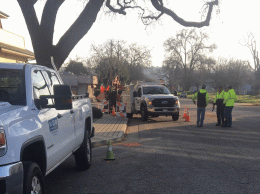Verizon Communications hopes to unload a quarter of its wireline telephone and Internet operations in a sale that would include all of its tri-county assets.
In one of the largest M&A deals announced to date, the telecom giant announced Feb. 5 that it plans to sell its wired assets in California, Texas and Florida to Frontier Communications for $10.5 billion as it steps away from the highly regulated, slower-growing technologies of its past.
The deal would also help Verizon pay off debt from last year’s buyout of Vodafone Group’s share in the companies’ joint U.S. wireless venture and a $10.4 billion spending spree earlier this month on wireless licenses at a government auction.
The company would not break down the size of the wireline market it gave up in the Tri-Counties specifically, but overall it dumped 3.7 million voice connections, 2.2 million broadband customers and 1.2 million FiOS TV subscribers.
In addition to thousands of legacy phone customers in Ventura and Santa Barbara Counties, Verizon maintains a headquarters in Newbury Park with about 1,100 employees. Frontier wouldn’t comment on the future of the headquarters.
Verizon Spokesperson Jarryd Gonzales declined to comment on whether California regulations or its market share played a role in the decision to sell the unit. He said the arrangement will help the company refocus on building out its fiber-optic platform, called FiOs, on the East Coast.
“The transaction is consistent with Verizon’s strategy to focus on wireless and growing FiOS penetration in contiguous markets in the Mid-Atlantic and Northeast that will allow for deeper adoption of Verizon’s leading fiber-optic services,” Gonzales said.
Verizon is already the nation’s largest wireless operator by subscribers and the sale would help accelerate growth in the sector, which already accounts for 69 percent of its annual $127 billion in revenue. And the wireless market is guaranteed to continue expanding as Americans solidify their reliance on mobile devices.
According to RootMetrics, a mobile analytics firm, Verizon’s wireless network in California bests those of AT&T, Sprint and T-Mobile in terms of speed, reliability, data performance and call performance.
Meanwhile Frontier, which operates in 28 states, is looking to build out its broadband service across California. The deal handed the company all of Verizon’s wired assets in the state, “so this is big,” Frontier Communications Senior Vice President Steve Crosby said. “It’s your home, your office, your broadband.”
The company would complement its existing market penetration in Northern California with Verizon’s Southern California assets, including the Los Angeles market. The deal is expected to close in the first half of 2016, and Crosby said while not much will change initially, Frontier ultimately plans to further develop infrastructure in the region.
“These are the kinds of areas where we do really well,” Crosby said of the Tri-Counties. “For us, our sweet spot is expanding broadband and providing quality network. Verizon’s focus is different now.”
The arrangement allows Verizon to shed a significant portion of its past. The company formed in 2000 following a merger between Bell Atlantic and GTE, formerly General Telephone & Electronics Corp., the company originally responsible for installing much of the Tri-Counties’ landline network. GTE also installed its West Coast headquarters in Thousand Oaks, and Verizon maintained the 426,000-square-foot building as its Pacific region headquarters until 2001, when it sold the facility to Baxter Healthcare Corp.
However, the company kept the facility’s 1,100 employees in Ventura County across three locations in Thousand Oaks and Newbury Park, where its Pacific region headquarters is currently located.
Verizon’s representative Gonzales could not comment on the future of its Newbury Park office or its employees, and Crosby said Frontier had not yet been given details on operations there.
Overall, about 11,000 Verizon employees across three states will become Frontier employees once the transaction closes, Gonzales said.
Frontier, originally named Citizens Utility Co., was founded in 1935 and has grown modestly via minor acquisitions. If approved, its latest deal will cap off a stretch of growth that took it from regional telecom company to a provider of phone and Internet service for more than half the country.
With market capitalization just below $8 billion, Frontier tripled in size following a deal in 2010 that gave it Verizon’s rural phone lines in 13 states, and it will double again if the recent deal is approved. While its growth is largely built on the uncertain future of wireline service, the latest deal could also hand Frontier a hunk of Verizon’s more lucrative fiber-optic infrastructure.
To exit the wired market in California, Texas and Florida, Verizon had to sacrifice a chunk of subscribers to FiOS, the fiber-optic network it has spent about $23 billion rolling out over the past decade, including Dallas, the market in which the service was first offered. The company spent $7 billion to develop FiOS connections in the three states.
Roughly 24 percent of Verizon’s FiOS Internet customers and 21 percent of its FiOS video customers will be dropped. Meanwhile, the percentage of homes in Frontier’s footprint enabled for fiber or other high-speed Internet will rise to 31 percent from 14 percent.
Verizon’s remaining landline assets are concentrated in New England, stretching down from New York and Massachusetts to Virginia and Washington, D.C.






 Print
Print Email
Email

















